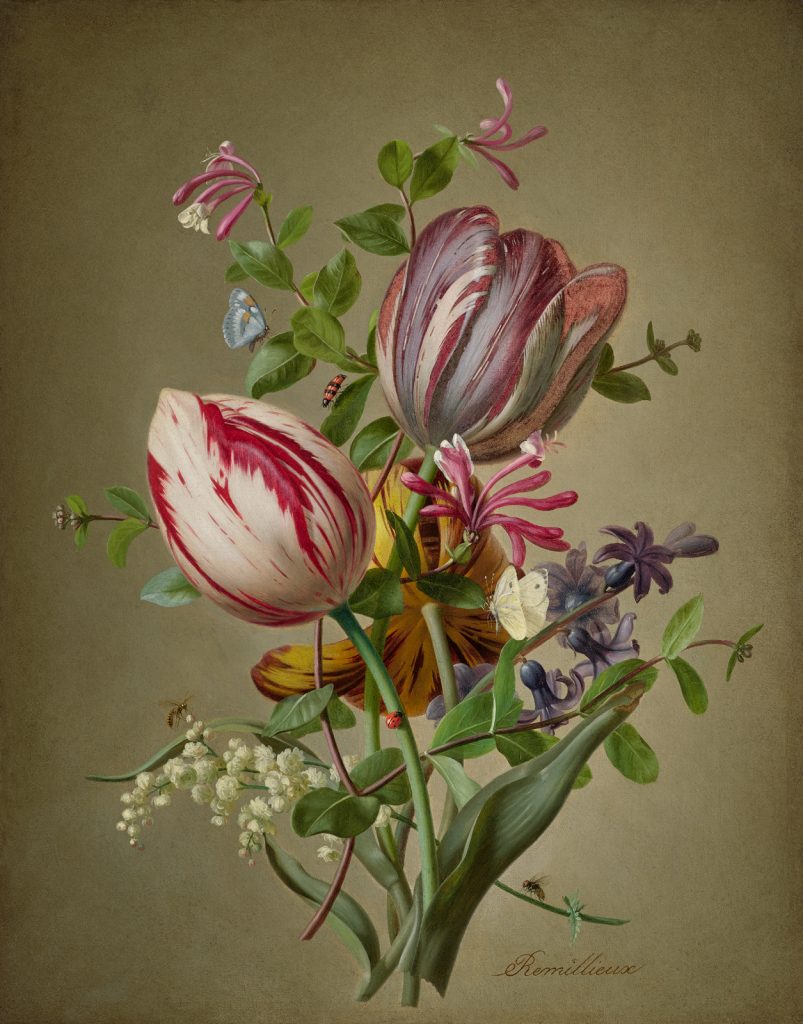Pierre Étienne Rémillieux
(Vienne, Isère 1811 - 1856 Lyon)
Bouquet of Vividly Striated Tulips and other Spring Flowers
Oil on canvas, 40 x 31.5 cm
Signed lower right Remillieux.
Provenance:
Private collection, Lyon
Literature:
Élisabeth Hardouin-Fugier and Étienne Grafe, La peinture lyonnaise au XIXe siècle, Paris 1995, p. 177
The efflorescence of flower painting in the early nineteenth century was a Europe-wide phenomenon. It was fueled by a new interest in nature, growing scientific interest in botany and the insatiable demand of leading European porcelain and textile manufactories for the refined workmanship of peintres-décorateurs. Schools for flower painting were set up, some independently run and others affiliated to local academies of art.
The textile industry dominated the economy of Lyon throughout the nineteenth century. In 1830, Lyon was the second largest city in France after Paris and had a population of around 165,000, of which an estimated 30,000 worked in the silk industry. Before the French Revolution and during the nineteenth century silk production was the pillar of Lyon’s prosperity. A school for flower painting was set up in 1795. It was integrated into the city’s newly established École nationale des beaux-arts in 1807.
The main objective of the École nationale des beaux-arts was to train artists to meet the enormous demands of the silk industry.[1] But many of the most talented alumni turned to painting in oils and went on to exhibit successfully at the Salons in Paris and Lyon.
Pierre Étienne Rémillieux was admitted to the École nationale des beaux-arts in 1828. He was a pupil of Augustin Thiérrat, a prominent figure in flower painting who led the flower painting class between 1823 and 1853. Rémillieux completed his training in 1833 and set up his own studio in Lyon. His trompe l’œil flower pieces achieved early recognition at the Salon in Lyon and were well received in Paris. He exhibited at the Salon from 1841 to 1855 and was awarded a second class medal in 1847. One of his paintings was shown at the Exposition Universelle in Paris in 1855.[2]
Three vividly striated tulip blooms – one in the color combination white-dark red, one yellow-dark red and one purple-white-dark red – dominate the present composition. The bouquet of spring flowers with its delicately delineated sprigs of hyacinth and honeysuckle is composed in trompe l’oeil manner and set against a background of subtle gradations of grey. No less detailed are the tiny insects – fly, bee, ladybird and striped blister beetle. Paintings by Rémillieux are extremely rare. The exceptionally fine condition of the painting – which is in its original frame – is therefore all the more pleasing.
1. Élisabeth Hardouin-Fugier and Étienne Grafe, The Lyon School of Flower Painting, Leigh-on-Sea 1978, p. 9.- See Patrice Béghain, Une histoire de la peinture à Lyon de 1482 à nos jours, Lyon 2011, p. 149.
2. See Hardouin-Fugier, 1978, p. 71.

